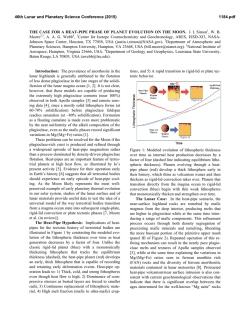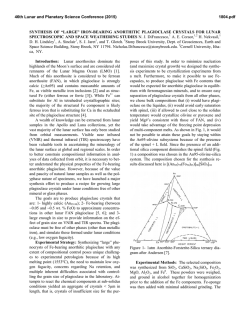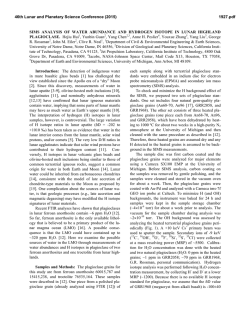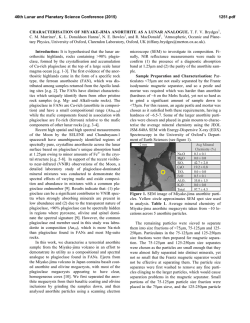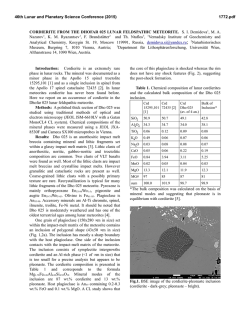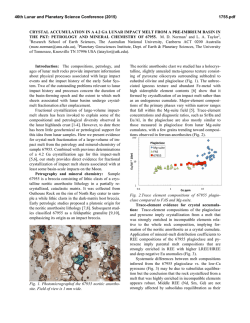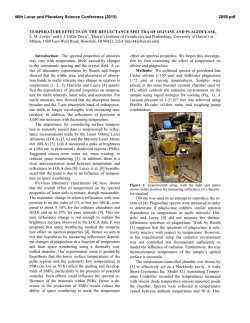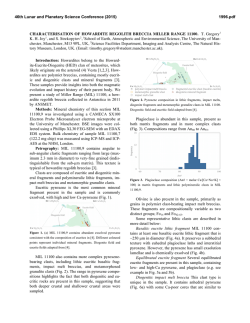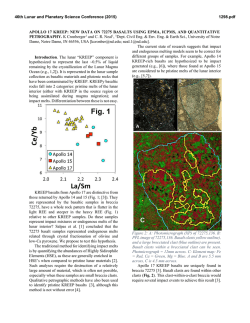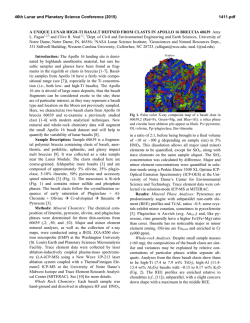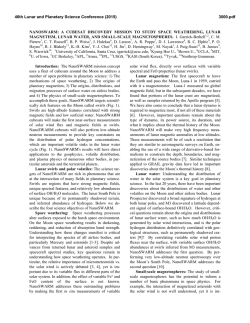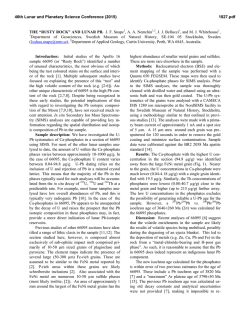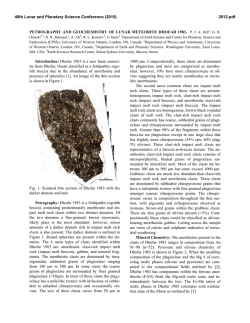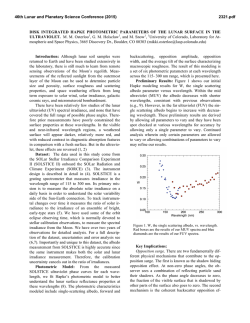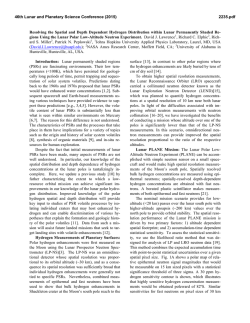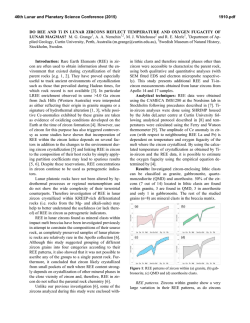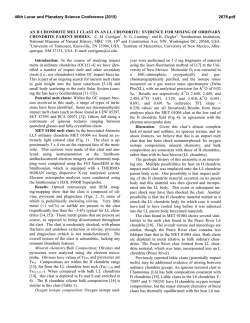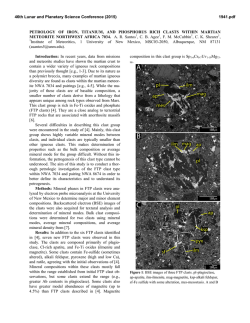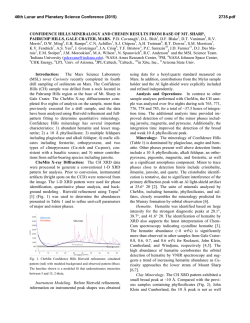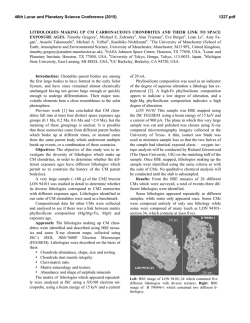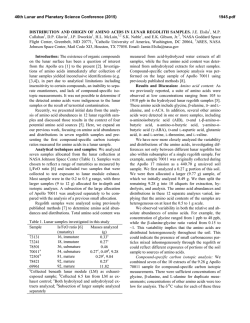
Are the Clast Lithologies Contained in Lunar - USRA
46th Lunar and Planetary Science Conference (2015) 1630.pdf ARE THE CLAST LITHOLOGIES CONTAINED IN LUNAR BRECCIA 64435 MIXTURES OF ANORTHOSITIC MAGMAS? J. I. Simon1, D. W. Mittlefehldt1, Z. X. Peng2, L. E. Nyquist1, C.-Y. Shih2, and A. Yamaguchi3, 1NASA-Johnson Space Center, Houston, TX 77058, USA ([email protected]). 2Jacob-JETS contract, NASA-JSC, Houston, TX 77058, USA, 3Antarctic Meteorite Research Ctr, NIPR, Tokyo 190-8518, Japan. Introduction: The anorthositic crust of the Moon is often used as the archtypical example of a primary planetary crust. The abundance and purity of anorthosite in the Apollo sample collection [1] and remote sensing data [2] are generally attributed to an early global magma ocean which produced widespread floating plagioclase cumulates (the ferroan anorthosites; FANs, [3]). Recent geochronology studies report evidence of young (<4.4 Ga) FAN ages, which suggest that either some may not be directly produced from the magma ocean or that the final solidification age of the magma ocean was younger than previous estimates [4]. A greater diversity of anorthositic rocks have been identified among lunar meteorites as compared to returned lunar samples (e.g., [5-8]). Granted that these lithologies are often based on small clasts in lunar breccias and therefore may not represent their actual whole rock composition. Nevertheless, as suggested by the abundance of anorthositic clasts with Mg# [Mg/(Mg+Fe)] less than 0.80 and the difficulty of producing the extremely high plagioclase contents observed in Apollo samples and the remote sensing data, modification of the standard Lunar Magma Ocean (LMO) model may be in order [4,9-12]. To ground truth mission science and to further test the LMO and other hypotheses for the formation of the lunar crust, additional coordinated petrology and geochronology studies of lunar anorthosites would be informative. Here we report new mineral chemistry and trace element geochemistry studies of thick sections of a composite of FAN-suite igneous clasts contained in the lunar breccia 64435 in order to assess the significance of this type of sample for petrogenetic studies of the Moon. This work follows recent isotopic studies [8,13] of the lithologies in 64435 focusing on the same sample materials and expands on previous petrology studies by [14] who identified three lithologies in this sample and worked on thin sections. Approach: Five thick sections of 64435 containing various igneous lithic clasts were initially examined and documented using backscattered electron imaging (BSE) on the JSC FE-SEM (e.g., Figure 1). Based on these images, major element compositions for mineral pairs (e.g., plagioclase+low calcium pyroxene, augite, or olivine) were obtained on the JSC electron microprobe employing a range of silicate mineral standards and conventional microprobe techniques. A representative selection of these mineral pairs were identified for laser ablation trace element analysis. The trace element abundances, in particular REE analyses were obtained as laser line profiles ~200-500 µm long and 50 µm wide in order to obtain sufficient analytical signal with the JSC Thermo-Fisher Element XR LAICPMS. In some cases mafic phases, obscured at the beginning of an individual analysis, were hit during ablation. These measurements were excluded from further consideration in this work. A. B. Mg#’s Mg# 0.71 Mg# 0.59 Mg# 0.76 0.70-0.76 Mg# 0.71 0.60-0.65 Mg# 0.71 Mg# 0.59 Mg# 0.65 Mg# 0.65 4 mm Figure 1. Backscattered electron image of compound anorthositic clast in lunar breccia 64435, 331. (A) shows that alkali contents of plagioclase are uniform (An96-98). (B) shows discrete regions with distinct mafic phase compositions (Mg#<0.65 vs. Mg#>0.70). Locations of electron probe and laser ablation trenches are shown for reference. Boundaries between lithologies can be difficult to identify in all studied samples. Results: Mineral compositions are generally similar to those reported by [8, 14] and the references therein (Figure 2). The exceptions include: (1) slightly lower Mg# in olivine (~0.72, this study) as compared to [8] (Mg# ~0.75) and (2) a population of olivine and low-calcium pyroxene) in 331 that have Mg# <0.65, which were not observed by [8]. The REE patterns measured in plagioclase are HREE depleted. Plagioclase from the low Mg# region of 64435, 331 (dashed red line, Figure 3), show no 46th Lunar and Planetary Science Conference (2015) distinction from the other analyses. All analyses exhibit a strong Eu anomaly as typically seen in igneous feldspar. A population of plagioclase in sample 64435, 330 have a similar, but slightly elevated pattern. Because all of the plagioclase in 330 show elevated patterns, it is unlikely that they all reflect analytical contamination from neighboring mafic minerals. Analyses of these neighboring mafic phases are in progress. 1.0 1.0 After [8] and the references therein 0.9 0.9 0.8 0.8 0.7 0.7 0.6 0.6 0.5 0.5 0.4 0.4 0.3 0.3 Figure 2. Plots of An component (mole%) in plagioclase versus Mg# (=Mg/(Mg+Fe) in mafic minerals in lunar anorthosites. (left) Compositions for pristine lunar rocks (blue shaded background [7]) compared to selected anorthosites from [8] and the reference therein, including analogous measurements of minerals in clast from 64435. (right) Mineral pairs of intergrown plagioclase and low-calcium pyroxene, augite, and olivine obtained from thick sections of 64435, this study. Symbols are color coded the same as the plot on the left. Low Mg# (<0.70) analyses come from one region of compound clast 64435, 331, see Fig. 1. 330 331 331 assocated w/low Mg#’s 332 333 334 Plagioclase Figure 3. Preliminary REE abundance patterns from 64435 plagioclase normalized to CI chondrite. Plagioclase in 64435, 330 appear slightly enriched relative to most plagioclase in the other four studied sections. Discussion: The uniform anorthite (An96-98) compositions measured in the studied samples are consistent with those found previously for 64435 and other 1630.pdf ferroan anorthosites [7]. The variability in Mg/(Mg+Fe) ratios determined for the mafic phases bridge the gap between FANs and the “Mg-suite” rocks that are highly magnesian, as has been reported for several other lunar meteorites (e.g., [7, 9; and the references therein). The region of sample 64435, 331 that has mafic minerals with Mg# <0.70, provides direct evidence for the mixture of materials, possibly pristine early FANs with more evolved materials as the range demonstrates that the sample is clearly not equilibrated. This observation implies that the final clast “lost” its chemically primitive magnesian signature and “gained” more evolved material perhaps by less primitive mantle-derived intrusions (e.g., [9,10]). This could have happened if the primordial crust was partially remelted and the dense mafic melt sank and the less dense plagioclase-rich material was intruded and refined by influx of more ferroan melts [i.e., 11,12]. The overall abundances of the REE in the studied plagioclase mimic the patterns of the bulk clasts in 64435 [8], but are lower as to be expected. The abundances are also lower as compared to the “enriched” patterns in plagioclase from magnesian anorthosite clasts in 64435 obtained by ion microprobe studies [15]. This is true even for plagioclase from the “more evolved” region of 64435, 331. REE analyses of the paired mafic phases should allow direct comparisons between the Mg#’s and REE abundance patterns. Sm-Nd, Rb-Sr, and Ar-Ar isotope systematics of 64435 rock fragments have been interpreted by [8, 13] to reflect a relatively young, ~3.5-3.9 Ga age. If these ages are correct they suggest that 64435 lithologies likely reflect anorthositic plutons that postdate the LMO. Given the complexity of petrologic components described herein, however, it is unclear what process(es) these model ages date. Mineral specific Sr isotopic tracer studies will be used to assess whether clasts exhibit isotopic equilibrium. Isotopic heterogeneity among minerals would pose a problem for determining accurate formation ages. References: [1] Haskin, L.A., et al (1981) LPI Tech. Report, 406–408 (1981). [2] Ohtake, M. et al. Nature 461, 236–240 (2009). [3] Warren, P.H. Ann. Rev. of EPS 13, 201– 240 (1985). [4] Borg L.E. et al. (2011) Nature 477, 70-72. [5] Takeda H. et al. (2006) EPSL, 247, 171-184. [6] Nyquist L.E. et al. (2006) GCA, 70, 5990-6015. [7] Yamaguchi A. et al. (2010) GCA, 74, 4507-4530. [8] Nyquist L.E. et al. (2014) LPSC, Abst. #1125. [9] Gross J. et al. (2014) EPSL, 388, 318-328. [10] Longhi J. (1978) Proc. 9th LPSC, 285-306. [11] Moore W.B. et al. (2014) LPSC, Abst. #1951. [12] Simon J.I. et al. (this meeting) LPSC, Abst. #1184. [13] Park J. et al. (2014) Met. Soc, Abst. #5197. [14] James O.B. et al. (1989) Proc. 19th LPSC, 219-243. [15] Floss C. et al. (1998) GCA, 62, 1255-1283.
© Copyright 2024
